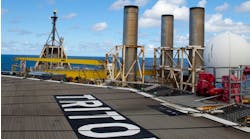Offshore supply vessel demand to remain stable in the Middle East, says analyst
Offshore staff
LONDON– The Middle East is the only region to buck the downward trend in offshore supply vessels (OSV) over the last two years, according to new analysis from IHS Markit.
Demand in the region has remained steadfast since the oil price decline began in 2014 and outpaced Southeast Asia, the Gulf of Mexico and the North Sea.
Demand for OSV in the Middle East was 2.6% higher in December 2016 than in January 2016, according to Petrodata, part of IHS Markit. That is an increase from an average of 270 vessels secured on term charters at the start of the year to almost 278 during the final month.
David Hunter, senior marine analyst at IHS Markit, said: “The increase may appear modest at first, but all other regions reported significant drops in activity across 2016.”
West Africa saw a 30% reduction, the US side of the Gulf declined 31%, and Mexico lost 53% of term work during last year, according to Petrodata.
New short- to medium-term opportunities are expected to open in theMiddle East offshore oil and gas market in the next 24 months.
According to theGlobal Offshore Supply Vessel Forecast issued by Petrodata, OSV demand in the region will remain firm and stable given the pipeline of drilling and field development projects, with an anticipated growth for OSV term demand from 118 vessels in 1Q 2016 to 145 vessels in 4Q 2018.
David Manuel, senior marine specialist from IHS Markit, said: “The Middle East offered some of the only bright spots and growth opportunities in the OSV market in 2016.
“Spending levels in the Middle East have been the least affected by the oil price slump because of relatively low break-even prices, many large ongoing projects, and the dominance of national oil companies, which have the long-standing pledge to keep production capacity in line with their market share.”
The region still has the highestjackup rig utilization levels compared to other regions and still the biggest jackup market in the world – a key indicator of OSV demand, Petrodata analysis said.
The opportunities for OSV in the Middle East have attracted idle tonnage from other markets affected by reduced exploration and production spending. The influx of vessels from other regions has resulted in a 14% increase in the number of OSV in the Middle East last year and brought utilization rates down to just 45%, according to Petrodata.
“OSV supply has risen considerably during the year from 553 vessels in January 2016 to a record-high of 625 vessels at present. This burgeoning supply is driving intense competition between local OSV providers and international players,” Manuel said.
The Middle East is now the second biggest global OSV market with 17% of the global fleet, behind Asia/Pacific. The shallow-water territory of the Middle East has overtaken OSV tonnage in the mature, deepwater markets of the Gulf of Mexico, northwest Europe, Latin America, and West Africa.
“The compounding glut will continue to be exacerbated by a wave of newbuild deliveries in the coming months almost entirely from Chinese yards,” Manuel said. “This newbuild backlog was either ordered by Middle Eastern owners or built on speculation by shipyards before the downturn. Moreover, a series of speculative mobilizations, mainly from Singapore, is also expected to further contribute to the oversupply in the next 12 months.
“The excessive regional tonnage has resulted to plummeting daily charter rates over the last three years, with several operators reporting a drop between 30 and 50% from its highs seen before the downturn.”
Earned day rates in the Middle East are reported to have bottomed out to almost breakeven levels last year, with AHTS vessels with DP-2 capabilities and 5,150 bhp getting around $7,500 per day.
According to Petrodata, a record 80 vessels have been laid-up in the region since 2014. This includes not only the older tonnage but also the competitive vessels.
“Interestingly, some vessels unable to pick up work have secured temporary charters outside the offshore oil and gas market. These vessels are temporarily serving in the civil engineering sector or providing logistical support to humanitarian and relief operations,” Manuel said.
03/02/2017


